RBSE Solutions for Class 11 Physics Chapter 8 Gravitation
Rajasthan Board RBSE Solutions for Class 11 Physics Chapter 8 Gravitation Textbook Exercise Questions and Answers.
Rajasthan Board RBSE Solutions for Class 11 Physics in Hindi Medium & English Medium are part of RBSE Solutions for Class 11. Students can also read RBSE Class 11 Physics Important Questions for exam preparation. Students can also go through RBSE Class 11 Physics Notes to understand and remember the concepts easily.
RBSE Class 11 Physics Solutions Chapter 8 Gravitation
RBSE Class 11 Physics Gravitation Textbook Questions and Answers
Question 8.1.
Answer the following:
(a) You can shield a charge from electrical forces by putting it inside a hollow conductor. Can you shield a body from the gravitational influence of nearby matter by putting it inside a hollow sphere or by some other means?
(b) An astronaut inside a small spaceship orbiting around the earth cannot detect gravity. If the space station orbiting around the earth has a large size, can he hope to detect gravity?
(c) If you compare the gravitational force on the earth due to the sun to that due to the moon, you should find that the sun’s pull is greater than the moon’s pull. (You can check this yourself using the data available in the succeeding exercises.) However, the tidal effect of the moon’s pull is greater than the tidal effect of sun. Why?
Answer:
(a) No, a body cannot be shielded from the gravitational influence of a nearby matter because the gravitational field produced at a point does not depend on the other bodies.
(b) Yes, if the mass of spaceship be so much that it may produce its own gravitational field.
(c) The tidal effect of a body in space is inversely proportional to cube of its distance, while gravitational force is inversely proportional to the square of distance. Since the distance of moon from sea level is very less than that of Sun, therefore the tidal effect of moon is more than that of Sun.

Question 8.2.
Choose the correct alternative:
(a) Acceleration due to gravity increases/decreases with increasing altitude.
(b) Acceleration due to gravity increases/decreases with increasing depth (assume the earth to be a sphere of uniform density.)
(c) Acceleration due to gravity is independent of mass of the earth/mass of the body.
(d) The formula - GMm(\(\frac{1}{r_2}-\frac{1}{r_1}\)) is more/less accurate than the formula mg (r2 - r1) for the difference of potential energy between two points r2 and r1 distance away from the centre of the earth.
Answer:
(a) Acceleration due to gravity decreases with increasing altitude because value of g at altitude h,
gh = \(\frac{g}{\left(1+\frac{h}{R_e}\right)^2}\)
(b) Acceleration due to gravity decreases with increasing depth because its value at depth d,
gd = g(1 - \(\frac{d}{R_e}\))
(c) Gravitational acceleration,
g = \(\frac{G M_e}{\left(R_e+h\right)^2}\)
where, Me is the mass of the earth. Therefore the value of g does not depend on the mass of the body.
(d) Formula for difference in potential energy between two points, -GMem (\(\frac{1}{r_2}-\frac{1}{r_1}\)) is more accurate than the relation mg(r2 - r1) because value of g varies on changing the place.
Question 8.3.
Suppose there existed a planet that went around the Sun twice as fast as the earth. What would be its orbital size as compared to that of the earth?
Answer:
Angular velocity (ω) of a planet around the Sun is given by
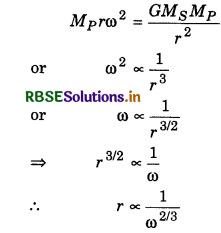
If rp and re be the radii of orbits of the planet and the earth respectively, then
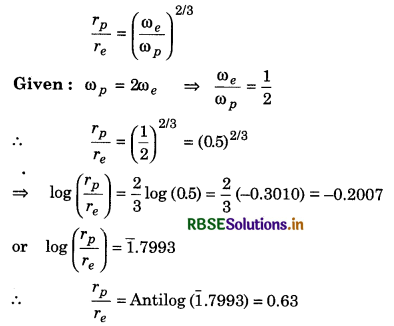
or rp = 0.63 re
i.e., The size of the orbit of planet ois 0.63 times the size of earth's orbit.
Question 8.4.
I0, one of the satellites of Jupiter, has an orbital period of 1.769 days and the radius of the orbit is 4.22 x 108 m. Show that the mass of Jupiter is about one thousandth that of the Sun.
Answer:
Time period of a satellite
T = 2π\(\sqrt{\frac{r^3}{G M_J}}\) ......................(1)
Here, T = 1.769 days = 1.769 x 24 x 60 x 60 s
= 1.53 x 105 s
Radius of the orbit, r = 4.22 x 108 m
∴ From equation (1),
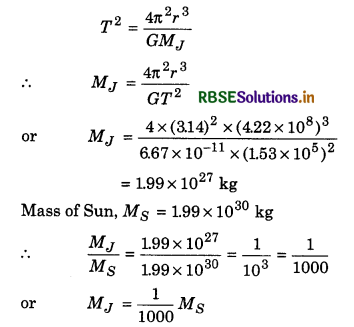
Question 8.5.
Let us assume that our galaxy consists of 2.5 x 1011 stars each of one solar mass. How long will a star at a distance of 50,000 ly from the galactic centre take to complete one revolution? Take the diameter of the milky way to be 105ly.
Answer:
Star revolves around milky way in similar manner as planets revolve around the Sun and the time period of stars.
T = 2π\(\sqrt{\frac{r^3}{G M_g}}\)
where, Mg = Mass of milky way
= 2.5 x 1011 MS = 2.5 x 1011 x 1.99 x 1030 kg
= 4.975 x 1041 kg
r = 50, 000 ly = 50000 x 9.46 x 1015 m = 4.73 x 1020 m
∴ T = 2 x 3.14\(\sqrt{\frac{\left(4.73 \times 10^{20}\right)^3}{6.67 \times 10^{-11} \times 4.975 \times 10^{41}}}\)
= 6.28 x 1.78 x 105 s = 11.17 x 1015 s
or T = \(\frac{11.17 \times 10^{15}}{3.15 \times 10^7}\) = 3.54 x 108 years.
Note: Since the distance of star is given from the centre of milky way, therefore there is no need of diameter of milky way in calculation.

Question 8.6.
Choose the correct alternative:
(a) If the zero of potential energy is at infinity, the total energy of an Orbiting satellite is negative of its kinetic/potential energy.
(b) The energy required to launch an orbiting satellite out of the earth’s gravitational influence is more/less tham the energy required to project a stationary object at the same height (as the satellite) out of the earth’s influence.
Answer:
(a) Total energy of the satellite revolving in orbit is equal to the negative value of its kinetic energy.
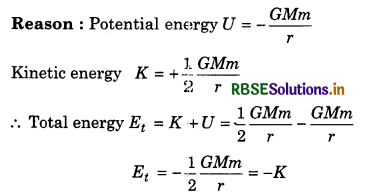
(b) The energy required to launch an orbiting satellite out of the earth’s gravitational influence is less than the energy required to project a stationary object at the same height (as the satellite) out of the earth’s influence.
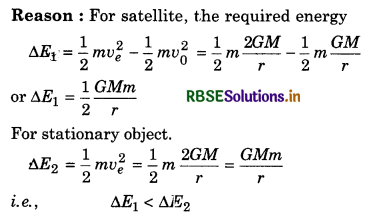
Question 8.7.
Does the escape speed of a body from the earth depend on (a) the mass of the body (b) the location from where it is projected, (c) the direction of projection, (d) the height of the location from where the body is launched?
Answer:
Escape speed from the earth,
ve = \(\sqrt{\frac{2 G M_e}{r}}=\sqrt{\frac{2 G M_e}{\left(R_e+h\right)}}\) ......................(1)
In this formula, the mass of the projectile, its location and the direction of projection are not there but only height h is there. Therefore the answers are:
(a) No, (b) No, (c) No and (d) Yes.
Question 8.8.
A comet orbits the Sun in a highly elliptical orbit. Does the comet have a constant (a) linear speed (b) angular speed, (c) angular momentum, (d) kinetic energy, (e) potential energy, (f) total energy throughout its orbit? Neglect any mass loss of the comet when it comes very close to the Sun.
Answer:
Force applied by Sun on the comet is central force, therefore angular momentum of the comet remains conserved i.e, constant.
Gravitational force applied on comet by the Sun is conservative force, therefore mechanical energy of comet remains constant.
Thus the answer are as under:
(a) The linear speed v (= rω) changes because the distance r of the comet from Sun remains changing due to its highly elliptical orbit.
(b) The angular speed of the comet changes because it traces different angles in equal intervals of time.
(c) Angular momentum remains constant.
(d) The kinetic energy of the comet changes because its linear speed remains changing.
(e) The potential energy of the comet changes as it is not at the same distance from the Sun due to highly elliptical orbit of the comet.
(f) Total energy is mechanical energy remains constant.
Question 8.9.
Which of the following symptoms is likely to afflict an astronaut in space (a) swollen feet, (b) swollen face, (c) headache, (d) orientational problem?
Answer:
(a) The feet have to bear the weight of a person in normal situation, but in a state of weightlessness an astronaut’s feet will not have to bear any weight. Consequently he will not be afflicted by swollen feet.
(b) An astronaut gets more than usual blood supply in the facial area due to absence of gravity. Hence he may develop swollen a face.
(c) Due to more than usual blood supply to the brain (in absence of gravity), the astronaut may suffer from headache.
(d) It is gravity which defines the vertical direction and hence the horizontal and all other directions. For an astronaut, who is experiencing no gravity, there are no vertical or horizontal directions and all directions are the same. Hence an astronaut has orientational problems as is evident from pictures of an astronaut floating in the satellite.
Question 8.10.
In the following two exercises, choose the correct answer from among the given ones: The gravitational intensity at the centre of a hemispherical shell of uniform mass density has the direction indicated by the arrow (figure a) (i) a (ii) b, (iii) c, (iv) d.
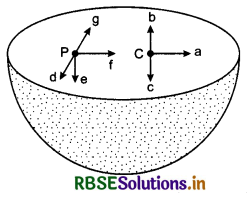
Answer:
At each internal point of spherical shell, gravitational potential remains constant, therefore gravitational intensity remains zero.
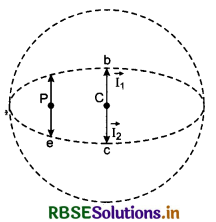
Since point C is symmetrical, therefore

Therefore gravitational intensity due to lower half hemispherical shell will be directed downwards and it will be indicated by arrow 'c'

Question 8.11.
For the above problem, the direction of the gravitational intensity at an arbitrary point P is indicated by the arrow (i) d, (ii) e, (iii) f, (iv) g.
Answer:
Due to this reason given in above question, the gravitational intesnity at any arbitrary point P will be indicated by (e).
Question 8.12.
A rocket is fired from the earth towards the Sun. Alt what distance from the earth’s centre is the gravitational force on the rocket zero? Mass of the Sun is = 2 x 1030 kg, mass of the earth = 6x 1024 kg. Neglect the effect of other planets etc. (Orlbital radius = 1.5 x 1011 m).
Answer:
Suppose at point P, the gravitational force on rocket becomes zero i.e., the gravitations on rocket due to the earth and the Sun become equal in magnitude. Therfore, from Newton’s law of gravitation,
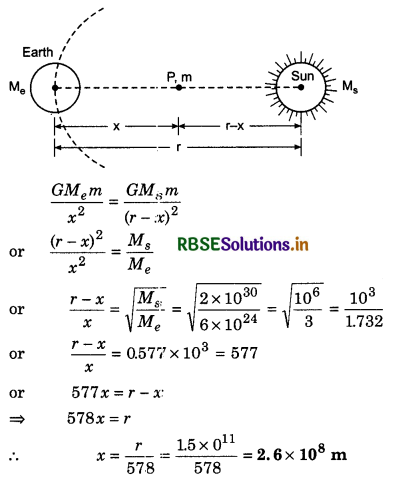
Question 8.13.
How will you ‘weigh the Sun’, that is estimate the mass of the Sun? The mean orbital radius of the earth around the Sun is 1.5 x 108 km.
Answer:
To weight the Sun we use the fact that earth completes its one revolution around the Sun in 1 years, and the gravitational force applied by the Sun on the earth, provides the required centripetal force for earth’s orbital motion.
∴ Merω2 = \(\frac{G M_s M_e}{r^2}\)
⇒ Mer (\(\frac{2 \pi}{T}\))2 = \(\frac{G M_s M_e}{r^2}\)
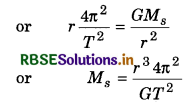
Here, r = 1.5 x 108 km = 1.5 x 1011 m
T = 365 x 24 x 60 x 60 = 3.15 x 107 s
= 6.67 x 10-11 Nm2 kg-2
∴ Ms = \(\frac{\left(1.5 \times 10^{11}\right)^3 \times 4 \times 9.86}{6.67 \times 10^{-11} \times\left(3.15 \times 10^7\right)^2}\)
= 2.0 x 1030 kg
Question 8.14.
A saturn year is 29.5 times the earth year. How far is the saturn from the Sun if the earth is 1.50 x 108 km away from the Sun?
Answer:
From Kepler’s third law of planetary motion:
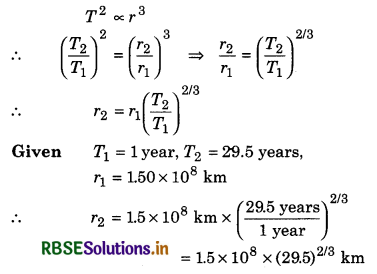
Taking log of both sides
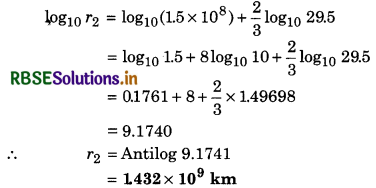
Question 8.15.
A body weighs 63 N on the surface of the earth. What is the gravitational force on it due to the earth at a height equal to half the radius of the earth?
Answer:
Weight of a body is the force applied by earth on the body.
At the surface of earth,
63 N = \(\frac{G M_e m}{R_e^2}\) .....................(1)
Height h = \(\frac{R_e}{2}\), gravitational force
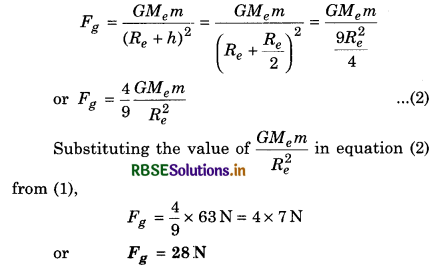
Question 8.16.
Assuming the earth to he a sphere of uniform mass density, how much would a body weight half way down to the centre of the earth if it weighed 250 N on the surface?
Answer:
Value of g at depth of x from earth’s surface is
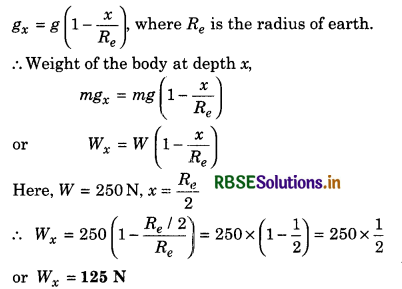
Question 8.17.
A rocket is fired vertically with speed of 5 km/s from the earth’s surface. How far from the earth does the rocket go before returning to the earth? Mass of the earth = 6.0 x 1024 kg, mean radius of the earth = 6.4x 106 m; G = 6.67x 10-11 Nm2/kg2
Answer:
From the law of conservation of energy, Decrease in kinetic energy = Increase in potential energy
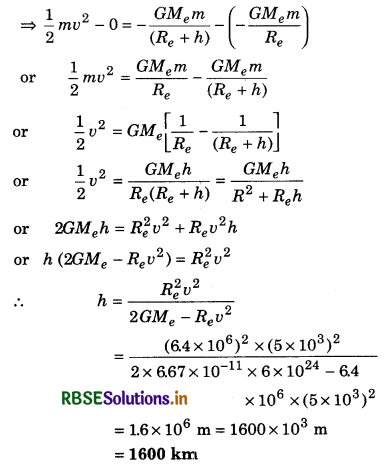
Question 8.18.
The escape speed of a projectile on the earth’s surface is 11.2 km/s. A body is projected out with thrice this speed. What is the speed of the body far away from the earth? Ignore the presence of the Sun and other planets.
Answer:
Given: Escape speed of the earth,
ve = \(\sqrt{\frac{2 G M_e}{R_e}}\) = 11.2 km/s .........................(1)
If the projection speed of the body is v = 3ve and its final speed (at infinity) is vf; then from the law of conservation of energy,
Total energy on earth's surface (Kinetic energy + Potential energy) = Total energy at infinity (Kinetic energy + Potential energy)
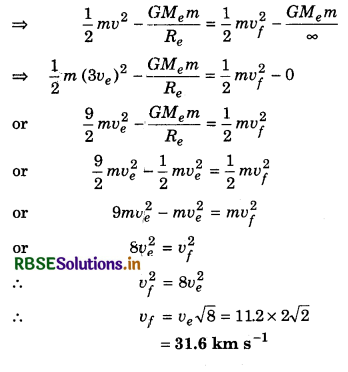
Question 8.19.
A satellite orbits the earth at a height of 400 km above the surface. How much energy must be expended to rocket the satellite out of the earth’s gravitational influence? Mass of the satellite = 200 kg; mass of the earth = 6.0 x 1024 kg; radius of the earth = 6.4 x 106 m; G = 6.67 x 10-11 Nm2/kg2.
Answer:
Total energy of orbiting satellite,
Et = \(-\frac{G M_e m}{2 r}=-\frac{1}{2} \frac{G M_e m}{\left(R_e+h\right)}\)
Out of gravitational influence (i.e., at infinity) its total energy = 0
If the energy given to a satellite for sending it out of gravitatinoal influence be E, then
E + Et = 0
or E = Et = \(\frac{G M_e m}{2\left(R_e+h\right)}\)
Here, m = 200 kg, h = 400 km = 0.4 x 106 m
G = 6.67 x 10-11 Nm2 kg-2
Me = 6.0 x 1024 kg
∴ E = \(\frac{1}{2} \times \frac{\left(6.67 \times 10^{-11}\right) \times\left(6.0 \times 10^{24}\right) \times 200}{(6.4+0.4) \times 10^6}\)
or E = 5.89 x 109 J
Question 8.20.
Two stars each of one solar mass (= 2 x 1030 kg) are approaching each other for a head on collision. When they are at a distance of 109 km, their speeds are negligible. What is the speed with which they collide? The radius of each star is 104 km. Assume the stars to remain undistorted until they collide. (Use the known value of G).
Answer:
Mass of each star M = 2 x 1030 kg
Initial distance between the stars, r1 = 109 km = 1012 m
Total initial energy of stars,
Ei = Initial kinetic energy + Initial potential energy
= 0 - \(\frac{G M M}{r_1}=-\frac{G M^2}{r_1}\)
When the stars strike each other, then distance between them r2 = 2R.
If the velocity of each star be v before collision, then total final energy
Ef = Final kinetic energy + Final potential energy
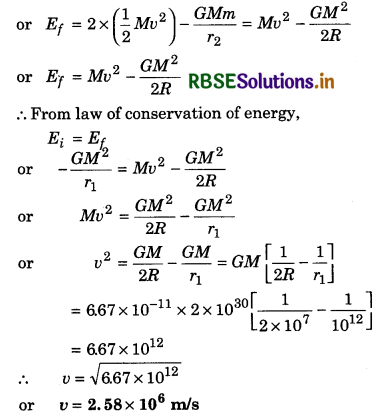

Question 8.21.
Two heavy spheres each of mass 100 kg and radius 0.10 m are placed 1.0 m apart on a horizontal table. What is the gravitational force and potential at the mid point of the line joining the centres of the spheres? If an object be placed at that point in equilibrium? If so, is the equilibrium stable or unstable?
Answer:
Mass of each sphere is supposed to be centered at its centre. Distance of each sphere from mid point C
r1 = r2 = \(\frac{r}{2}=\frac{1.0}{2}\) = 0.5 m
Mass of each sphere, M1 = M2 = 100 kg
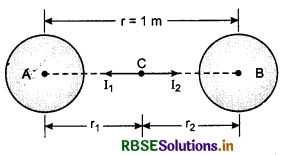
Gravitational field: Gravitational field at C due to the sphere A.
I1 = \(\frac{G M_1}{r_1^2}(\text { along } \overrightarrow{C A})\)
Similarly gravitational field at C due to the sphere B.
I2 = \(\frac{G M_2}{r_2^2}(\text { along } \overrightarrow{C B})\)
∴ Resultant gravitational field at C,
I = I1 ~ I2 = \(\frac{G M_1}{r_1^2} \sim \frac{G M_2}{r_2^2}\) = 0
or I = 0
Because M1 = M2 = 100 kg
r1 = r2 = 0.5 m
∴ \(\frac{G M_1}{r_1^2}=\frac{G M_2}{r_2^2}\)
Gravitational potential: Gravitational potential at C due to both the spheres
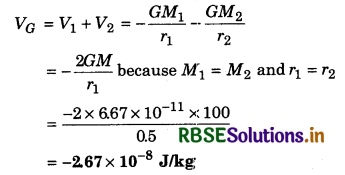
Since intensity of gravitational field at C is zero, therefore force acting on any body of mass m will be zero. Hence the body will be in equilibrium.
This equilibrium is unstable; because if the body is slightly displaced from this point, it goes on moving in same direction and does not return back to point C.
Additional Exercises
Question 8.22.
As you have learnt in the text, a geostationary satellite orbits the earth at a height of nearly 36,000 km from the surface of the earth. What is the poten tial due to the earth’s gravity at the site of this satellite? (Take the potential energy at infinity to be zero). Mass of the earth = 6.0 x 1024 kg, radius = 6400 km.
Answer:
Gravitational potential at the height h from the earth’s surface,
VG = \(-\frac{G M_e}{\left(R_e+h\right)}\)
Here, Me = 6.0 x 1024 kg;
G = 6.67 x 10-11 Nm2/kg2
h = 36000 km = 3.6 x 104 km = 3.6 x 107 m
Re = 6400 km = 64 x 106 m
∴ VG = \(-\frac{6.67 \times 10^{-11} \times 6 \times 10^{24}}{\left(6.47 \times 10^6+36 \times 10^6\right)}\)
= \(-\frac{6.67 \times 10^{-11} \times 6 \times 10^{24}}{42.4 \times 10^6}\)
or VG = -9.4 x 106 J/kg
Question 8.23.
A star 2.5 times the mass of the Sun and collapsed to a size of 12 km rotates at a speed of 1.2 rev. per second. (Extremely compact stars of this kind are known as neutron stars. Certain stellar objects called pulsars belong to this category.) Will an object placed on its equator remain stuck to its surface due to gravity? (Mass of the Sun = 2 x 1030 kg).
Answer:
Two forces act on an object placed at the equator,
(i) Gravitational force Fg = mg directing inside, and
(ii) Centrifugal force Fc = mRω2 directing outward.
If Fg > Fc, then object will remain stuck on the surface of the star and vice-versa.
Value of g on the star,
g = \(\frac{G M}{R^2}=\frac{G \times\left(2.5 M_s\right)}{R^2}\)
where, Ms = Mass of Sun = 2 x 1030 kg
R = Radius of the star = 12 km
= 12 x 103 m
∴ Gravitational force Fg = mg = \(\frac{m G\left(2.5 M_s\right)}{R_{30}^2}\)
or Fg = m x \(\frac{6.67 \times 10^{-11} \times 2.5 \times 2 \times 10^{30}}{\left(12 \times 10^3\right)^2}\)
= 23 x 102 mN.
Centrifugal force on the object,
FC = mω2R = m (2πn)2 R
= m x (2 x 3.14 x 1.20)2 x 12 x 103
= (6.8 x 105 x m) N
∵ Fg < Fc,
∴ The object will remain stuck on the surfaces of the star.

Question 8.24.
A spaceship is stationed on Mars. How much energy must be expended on the spaceship to launch it out of the solar system? Mass of the spaceship = 1000 kg; Mass of the Sun = 2x 1030 kg; Mass of Mars = 6.4x 1023 kg; radius of Mars = 3395 km; radius of the orbit of Mars = 2.28x 108 km, G = 6.67 x 10-11 Nm2/kg2.
Answer:
Energy of spaceship of mass m with Mars, revolving around the Sun,
= Kinetic energy + Potential energy
= \(-\frac{G M_s m}{2 r}\)
Where Ms is mass of Sun and r is the orbital radius of Mars around Sun.
Potential energy of spaceship due to Mars.
U1 = \(-\frac{G M_m m}{R_m}\)
Where Mm is Mass of mars and Rm is its radius.
∴ Potential energy of spaceship resting on Mars,
= \(-\frac{G M_s m}{2 r}-\frac{G M m}{R_m}\)
If EK be the minimum energy given to spaceship for escaping out of solar system, then
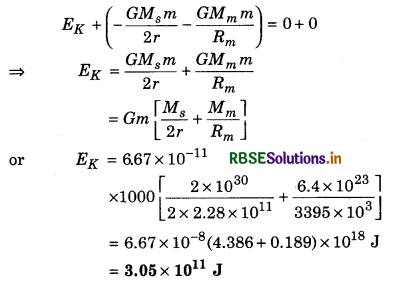
Question 8.25.
A rocket is fired ‘vertically’ from the surface of Mars with speed of 2 km/s. If 20% of its initial kinetic energy is lost due to martian atmospheric resistance, how far will the rocket go from the surface of Mars before returning to it? Mass of Mars = 6.4x 1023 kg; Radius of Mars = 3395 km; G = 6.67x 10-11 Nm2/kg2.
Answer:
When rocket goes upwards, then its kinetic energy changes into potential energy. At highest point its kinetic energy becomes zero. Since 20% kinetic energy is consumed against atmospheric resistance of changes into potential energy. If H be the maximum height of the rocket, then from the law of conservation of energy
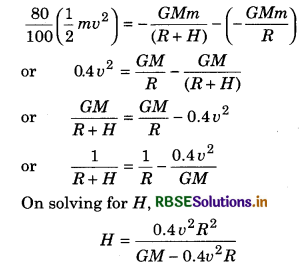
Here, v = 2 km/s = 2 x 103 m/s; R = 3395 km = 3.395 x 106 m; M = 6.4 x 1023 kg;
∴ H = \(\begin{aligned} & \frac{0.4 \times\left(2 \times 10^3\right)^2 \times\left(3.395 \times 10^6\right)^2}{6.67 \times 10^{-11} \times 6.4 \times 10^{23}-0.4} \\ & \times\left(2 \times 10^3\right)^2 \times 3.395 \times 10^6 \\ & \end{aligned}\)
= \(\frac{18.44 \times 10^{18}}{42.69 \times 10^{12}-5.43 \times 10^{12}}\)
= \(\frac{18.44 \times 10^{18}}{37.26 \times 10^{12}}\)
= 0.4949 x 106 m
= 494.9 x 103 m = 49.9 km

- RBSE Class 11 Physics Important Questions Chapter 4 Motion in a Plane
- RBSE Solutions for Class 11 Physics Chapter 15 Waves
- RBSE Solutions for Class 11 Physics Chapter 14 Oscillations
- RBSE Solutions for Class 11 Physics Chapter 13 Kinetic Theory
- RBSE Solutions for Class 11 Physics Chapter 12 Thermodynamics
- RBSE Solutions for Class 11 Physics Chapter 11 Thermal Properties of Matter
- RBSE Solutions for Class 11 Physics Chapter 10 Mechanical Properties of Fluids
- RBSE Solutions for Class 11 Physics Chapter 9 Mechanical Properties of Solids
- RBSE Solutions for Class 11 Physics Chapter 7 System of Particles and Rotational Motion
- RBSE Solutions for Class 11 Physics Chapter 6 Work, Energy and Power
- RBSE Solutions for Class 11 Physics Chapter 5 Laws of Motion